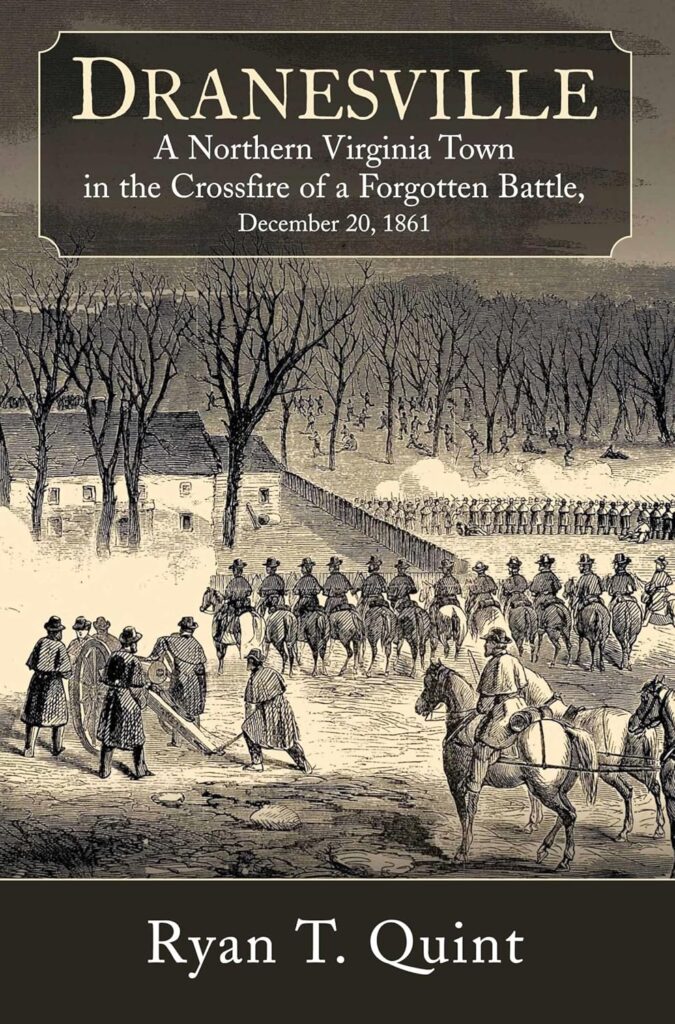By Ryan T. Quint.
El Dorado Hills, CA: Savas Beatie, 2024.
ISBN 978-1-61121-6936. Notes, Maps. Notes. Bibliography. Index.
Pp. 234. $32.95.
On 20 December 1861, Union and Confederate foraging parties met near Dranesville, a hamlet in northern Virginia. The Federal force was commanded by Brigadier General Edward O.C. Ord and numbered about 3,600 men that included infantry, cavalry, and artillery. The Confederate forces were organized similarly but only numbered about 2,000 men and were commanded by Brigadier General J.E.B. Stuart. The two sides met at the outskirts of the village in what is known in military parlance as a “meeting engagement.” The Federals arrived a few minutes earlier and were familiar with the area from earlier reconnaissance missions, so they were able to establish themselves in two farmhouses. The Confederates came from a different direction and found themselves hemmed in by pine forests that severely limited their ability to deploy their artillery. The result of the two-hour battle was a Federal victory with three times as many casualties for the Confederates as those suffered by Union troops.
Ryan T. Quint recounts the events in the months leading up to this battle at Dranesville and the surrounding area. He demonstrates that even such small battles had a big impact not only on the men involved, but on the area in which the battles were fought. Moreover, one of the points that Quint attempts to draw is that there was much internal friction in the village itself between those citizens who supported secession and those who supported the Union. Those divisions contributed to the actions that led to the battle and its aftermath. To accomplish these tasks, Quint adds some aspects that are not directly associated with the battle, including a bar fight some years before the Civil War, all kinds of harassments suffered by those residents who supported the Union, as well as an ambush that the local Home Guard conducted on a different Federal unit some months before in which several Federal soldiers were killed.
Quint analyzes how Ord and Stuart conducted themselves during the battle and how their careers progressed after it. It is clear that Ord was the better general here. Stuart does not come off well, and Quint does not shy away from explaining why that is. Their careers after this battle are covered in brief, along with the lessons they learned in this battle, and how they later applied those lessons
Just like Ball’s Bluff and several other battles or events referenced in the book, this battle resulted from the Army of the Potomac’s slow and cautious probing of northern Virginia and its attempt to push the Confederate Army back after First Bull Run. In the aftermath of this battle, both sides returned to their base area, and their measured movements continued until the spring Peninsula Campaign. Quint claims that this battle revived the flagging morale of the Army of the Potomac, which was still reeling from the debacle of Ball’s Bluff and other defeats. This thread, however, is not very well supported by Quint, who otherwise has conducted an impressive amount of research as shown in the book’s notes and bibliography. Key sources include personal journals, letters, and other records.
As Dranesville is a little-known battle, this book is probably best suited for readers who have an interest in the specific individuals or units that were involved in the events described here, or those with an interest in the Civil War in northern Virginia. No unique tactics or special battlefield events took place during the battle to distinguish this one from many others. Therefore, this is a relatively specialized volume dealing with a specialized topic, in a sense.
Naor Wallach
Canonsburg, Pennsylvania
